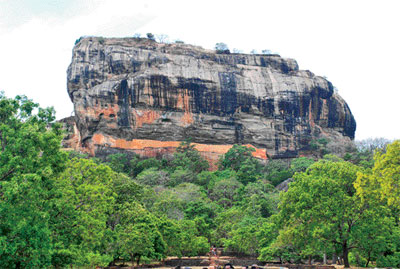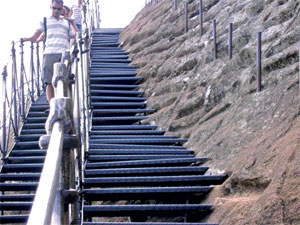Holding the mighty rock together
By Dhaneshi YATAWARA
It is amazing how a giant rock standing in the middle of a great
plateau has mesmerised humans for many centuries. Kings were enthralled
by its natural fortress-like structure and the creations of their
artistes and architects still astound visitors from all over the world.
 This
rock, a unique witness to the great Sri Lankan civilisation, stands in
Dambulla of the Matale district and is known as Sigiriya or the Lion's
Rock. It was the capital city of a patricidal king, yet not a single
trace of this brutality is evident in the fortress. This
rock, a unique witness to the great Sri Lankan civilisation, stands in
Dambulla of the Matale district and is known as Sigiriya or the Lion's
Rock. It was the capital city of a patricidal king, yet not a single
trace of this brutality is evident in the fortress.
As history depicts, this city of ruins which we see today is what
King Kashyapa built during his reign from 477 BC to 495 BC. King
Kashyapa killed his father King Dhathusena to grab the kingdom and later
cast out his brother Mugalan. Fearing the return of his brother with a
vengeance, Kashyapa selected the Lion's Rock to build his fortress,
according to the Mahavamsa, the chronicle of Sri Lanka's history.
During the 11 years that Kashyapa resided in Sigiriya, he created
exceptional splendour. In 495 BC, after a battle that lasted for a short
period, Kashyapa was killed and Mugalan returned Sigiriya to the
bhikkhus to which it had belonged.
The Sigiriya Rock, proof of the great Sri Lankan civilisation, is
aging today. As no law stands above the rules of Mother Nature, this
solid rock fortress is peeling off through a procedure scientifically
known as weathering. Slabs of loose rock have been found on Sigiriya by
geologists.
|

Environment Minister Anura Priyadarshana Yapa
during an inspection tour |
"First this was noticed by Dr. Shiran Deraniyagala who informed the
Geological Survey and Mines Bureau to come up with a mechanism to
preserve this historic site", said Chairman of the Geological Survey and
Mines Bureau (GSMB) Dr. N.P. Wijayananda explaining the launch of a
joint expedition of science and archaeology.
Historic value
"This is natural and it happens to all rocks. But considering the
historical value of Sigiriya and the fact that thousands of local and
foreign tourists visit this place, it was important to stop these loose
rock slabs from falling", Dr. Wijayananda said. If such rocks fall on a
visitor, it could mean danger for every single tourist to Sigiriya", he
said.
Weathering is a natural phenomenon where rocks, soils or minerals
break down through contact with the atmosphere, plants, animals or
water. This happens in two ways - i.e. chemical weathering and physical
weathering. Chemical weathering happens as a result of the direct effect
of atmospheric or biologically produced chemicals.
Physical weathering is the break-down of rocks as a direct result of
environmental conditions such as heat, water, pressure and in some parts
of the world, ice. The material left over after the rock breaks down
combined with organic material creates soil.
Preserving the Lion's Rock - the hardened magma plug that rises 1,214
feet above sea level - against weathering is not a simple task.
"Initially we identified six spots on Sigiriya with loosened rock. For
the past 12 years we have been carrying out the renovation and
identifying risky spots on the rock", Dr. Wijayananda said.
|

The new staircase |
With many ups and downs, the GSMB has now completed the task with the
support of the Ministry of Environment. "The rock has been saved
entirely with our indigenous expertise. The work itself is a wonder. The
path to success was not a bed of roses for the GSMB."
Several offers
|

GSMB Chairman
Dr. N. P. Wijayananda |
"There were several offers from other organisations to carry out this
task using huge scaffolding built from the bottom of the rock, which was
too costly. So we developed, with our experience in working with mines,
a much more eco-friendly and cost-effective method to meet the
challenge", he said.
Armed with a team of five or six members, including two senior
technical officers, R. Manchanayake and B.D. Sirisena who had much
experience at the Kahatagaha mines, the project to hold Sigiriya in one
piece was launched with Udaya de Silva, Assistant Director (Geology) of
GSMB under the instructions of Chairman Dr. Wijayananda.
The skilled workers were those who had retired early from the
Kahatagaha mines and were familiar with such geological situations. The
final part of the project, carried out over the past one and a half
years, has cost Rs. 52 million.
The weathering stone patches had to be anchored to the mother rock
using stainless steel rods. "Earlier anchoring was done using steel
rods, but with time steel erodes. Thus we had to use stainless steel
that will last forever". Senior Technical Officer R. Manchanayake said.
It was a tedious task mostly carried out manually as machines would
create a vibration that could have destroyed this architectural
masterpiece. The workers had to embed stainless steel rods in to the
loosened rock until they reached the mother rock, to provide stability.
All the work had to be done manually. While working on the sides of the
rock, the workers had to hang on to ropes with safety belts around their
waists.
|

No machinery was used in the process |
Platform eroded
The GSMB was instructed to repair the pocket of frescoes of which
half remained closed for a long time as the platform had eroded. The
GSMB team, after putting up a better platform under the frescoes pocket,
renovated the entire viewer's platform. "We had to seek special
permission and work in the nights as well since there was a lot of work
to be done", Dr. Wijayananda said.
|

Work at the pocket of frescoes |
Day and night the GSMB staff toiled to preserve the rock with nothing
but their bare hands. The staircase to the granite peak has been
expanded, doubling its size. During renovation, it was observed that the
outer side of the mirror wall was exfoliating. Again, setting up another
working platform outside the wall on the steep rock,the GSMB team
started pasting the patches. It was then (2004) that they came across
some undiscovered frescoes drawn outside the mirror wall. It was a
magnificent archaeological finding for Sri Lanka in recent history. "We
cannot stop the weathering of the rock, but what we can do is anchor the
loose rock to the mother rock where necessary. We need to periodically
monitor and identify such spots", Dr. Wijayananda said.
He also highlighted the importance of mitigating the physical
weathering of the rock by tree roots by uprooting trees from rock
surfaces. "This is important because, though the trees provide shelter
to the rock against the harsh sun, the damage done by the roots is far
greater", Dr. Wijayananda said.
Today, with the effort of the GSMB team under the Ministry of
Environment, Sigiriya has become a safe place to visit. It is the
efforts of our brave men from villages which continue to prove that Sri
Lankans still have the knowledge and courage of our predecessors who
gave us such wonders of the world. |

